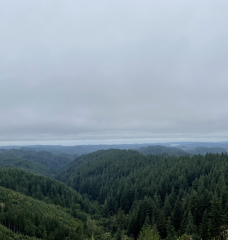
This story by MIT Environmental Solutions Journalism Fellow Alex Baumhardt was originally published in the Oregon Capital Chronicle, where it appears with additional photos and resources.
Oregon’s leaders decided for the first time to dedicate an entire state forest to storing harmful greenhouse gases to combat climate change while generating revenue from selling carbon credits.
The fate of the Elliott State Forest near Coos Bay has been the subject of intense negotiation for years, but on Tuesday morning the three members of the State Land Board – Gov. Tina Kotek, Secretary of State LaVonne Griffin-Valade and state Treasurer Tobias Read – voted unanimously to support a proposed forest management plan for the Elliott’s future that prioritizes research, protecting animal habitat, increasing forest carbon storage to combat climate change and produce income from the sale of carbon credits. Logging would still be allowed in parts of the forest, but would be significantly reduced from previous decades.
The decision makes Oregon the second state nationwide to enroll an entire state forest in a plan focused on storing harmful emissions in exchange for carbon credits, after Michigan.
In Oregon, the forest management plan includes registering all 83,000 acres of the Elliott in the voluntary carbon crediting market to generate millions of dollars for the state. Voluntary markets are not tied to any government-regulated emissions reduction laws, such as California’s cap-and-trade program, or Washington’s cap-and-invest program.
Approval of the plan has been a long time coming, and Vicki Walker, director of the Department of State Lands, visibly choked up as she presented it to the board in Salem. “From a deeply conflicted past we have and continue to move towards the future that this plan represents: The Elliott as a nationally important center for forest science and management that also contributes to the things we value – conservation, education, recreation and the economies right here in Oregon and the south coast,” she said.
Not everyone supports the idea. Last year, two of the Elliott’s planning partners – Oregon State University and the Confederated Tribes of the Coos, Lower Umpqua and Siuslaw Indians – backed out of partnering on the project, citing concerns that putting the entire forest into a carbon storage and crediting scheme would limit research and logging. Department officials said they are in ongoing talks with OSU and the Confederated Tribes of the Coos, Lower Umpqua and Siuslaw Indians to continue finding a way to collaborate.
Officials at the Department of State Lands anticipate that the plan will go into effect next year, following finalization of a habitat conservation plan currently being reviewed by federal agencies. The forest management plan will allow a resumption of some logging for the first time in eight years. State land officials will soon ink an agreement with the carbon crediting company Anew Climate to manage the planning and brokerage of the carbon storage and crediting scheme for the forest.
Brett Brownscombe, Elliott State Forest transition director at the Department of State Lands who spoke to the board with Walker on Tuesday, said the plan is unique in Oregon and nationally. “Combining a habitat conservation plan, a carbon project and a research forest on the same landscape would be precedent-setting.”
Michigan is the only state that has entire state forests generating credits for the carbon markets, with two of its state forests listed in the American Carbon Registry, the first voluntary greenhouse gas registry in the world that monitors projects and issues carbon credits.
At the meeting, Kotek, Griffin-Valade and Read also approved the addition of three members to the Elliott State Research Forest Board of Director: Payton Smith, director of communications and government affairs for Southport Lumber in Coos Bay; Michael Wilson, former natural resource director for the Grand Ronde Tribe; and Jennifer Allen, former professor of environment and natural resources at Portland State University, who previously served on the board. Smith and Wilson were appointed to one-year terms and Allen to a two-year term. They’ll join the six other members.
Stumpage to storage
The Elliott was intensively logged for much of the last century to provide revenue for Oregon schools. Logging for school revenue stopped in 2016, and in 2022, it became a research forest. Today, it is among the largest research forests in the nation.
Under the new forest management plan, intensive logging, including clear-cutting, would be allowed on about 25% of the forest, and selective cutting of 80- to 100-year-old trees would be allowed on about 13% of the forest. Portions of the remainder of the forest could be thinned to promote habitat and forest health and biodiversity, but otherwise would be managed for research, animal habitat and carbon storage, according to the plan.
Under a proposed 40-year feasibility study developed by Anew Climate, the state’s new forest management plan could potentially capture and store up to 435,000 additional metric tons of carbon dioxide – the equivalent of taking about 100,000 gas-powered cars off roads for a year. Each ton would be worth one carbon credit that could be sold to companies to offset some of their greenhouse gas emissions.
The credits could be worth nearly $9 million on carbon markets over the next decade, Anew’s study said.
University and Indigenous concerns
In November 2023, after five years of work on the Elliott, Oregon State University officials and members of the Confederated Tribes of the Coos, Lower Umpqua and Siuslaw Indians bowed out of partnering on the forest management plan. The university’s new president at the time, Jayathi Murthy, cited the carbon crediting scheme in a letter to the State Land Board as one of the reasons for the pullback. OSU officials and the tribes have said they oppose scaling back or ending commercial logging on large swaths of the forest for a set period and worry that the carbon crediting plan would limit research.
“Such research would not be possible if large tracts of the forest are rendered unavailable because they’ve been set aside under long-term (40- or 100-year) commitments through carbon markets that are currently the subject of academic and public scrutiny,” Rob Odom, vice president of university relations, previously told the Capital Chronicle.
The voluntary carbon crediting market has come under scrutiny in recent years for lacking regulations and oversight to ensure each ton of carbon dioxide released by a polluter is offset by a metric ton absorbed by a landowner. Critics also say they provide only a temporary solution for harmful emissions that cause climate change. After a 40- or 100-year contract for carbon storage has been fulfilled, a landowner could log it all, or use the land for something else. Others worry the markets only delay a necessary transition away from fossil fuels within the next century by letting polluters buy their way out of making urgent changes.
More than 450 people weighed in on the plan during the public comment period between June 12 and Aug. 4, and most were in favor.
Walker addressed OSU concerns and comments at the meeting Tuesday.
“There are still people who are not happy. They want it to be like the old days, where we just cut all kinds of trees. We can’t do that anymore,” Walker said. “We have to respect the fact that this forest has limitations, and I think we have found a way to satisfy the bulk of all of those interests and to get us to a place of reconciliation.”
Kotek wrapped up the discussion of the Elliott by saying, “The work is never done. I think we all know that, but this is an incredible and strong place to be.”





